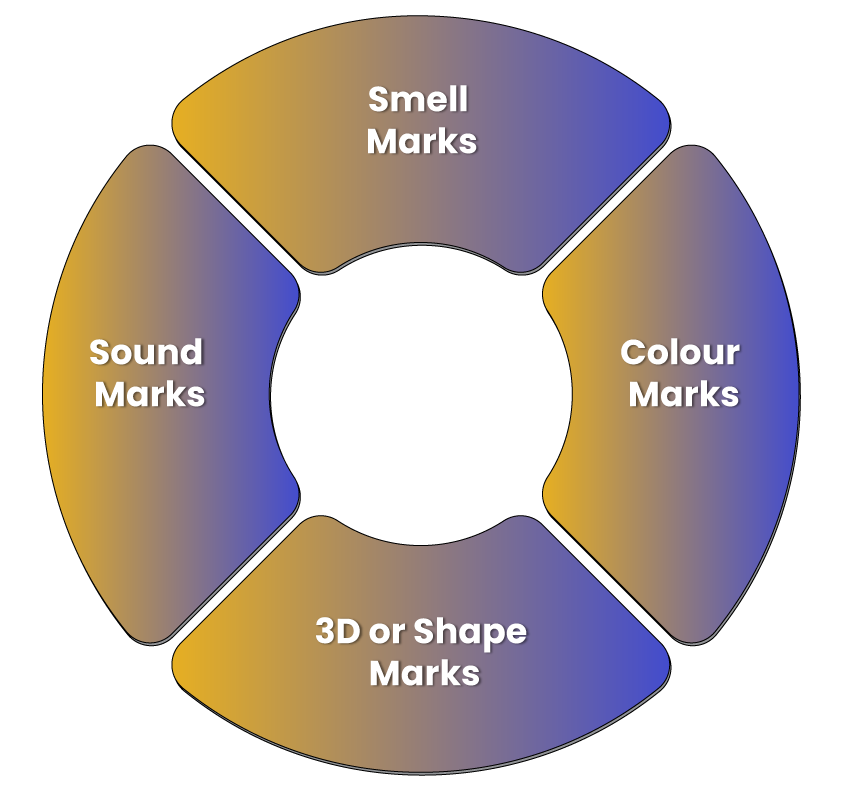What are the 4 Best Non-Conventional Trademarks?

Karan Singh | Updated: Aug 28, 2021 | Category: Trademark
Non-Conventional Trademarks can be understood in the way of any mark that does not come under the traditional domain of either being a symbol, name, logo, or word and capable of non-visual marks such as smell, taste, texture, sounds, etc. Hence, it is not about what it comprises but more about what is exempted from the conventional category of things. The types of Non-Conventional Trademarks can be largely categorised in visual marks such as holographic marks, colour marks, trade dress, motion marks, and non-visual marks like an olfactory mark, sound mark, and taste mark. The originality of the mark but doesn’t award it any rights beyond that of a traditional Trademark. In this blog, we are going to discuss the 4 best Non-Conventional Trademarks.
Table of Contents
What is a Trademark?
Before we discuss the 4 best Non-Conventional Trademarks, it is important to understand the meaning of Trademark. A Trademark is any mark or sign used to differentiate the products and services of one individual from the other to identify the origin of such products and services. A Trademark only refers to words, logos, or symbols. This understanding is only partially proper since logos, words, and symbols are not the only marks capable of being used as a Trademark for one’s company or business. With the beginning of the development of Intellectual Property Law – other types of marks such as smell, texture, shape, sound, shape, taste can also be trademarked. These developments have manifested in different ways, and the most outstanding of which is the International Agreement on TRIPS (Trade-Related Aspects of Intellectual Property Rights), which lays down the meaning and specific minimum standards concerning Intellectual Property Rights (IPR) comprising Trademarks.
4 Best Non-Conventional Trademarks
Following are the 4 best Non-Conventional Trademarks:

- Sound Marks: It’s a type of mark where a sound is used as a Trademark. With the increase of social media platforms utilising audio features such as Instagram Reels, YouTube Shorts, etc., sound has assumed a vital role in recognising a business. Generally, there are two essential necessities for Sound Mark Registration:
- The application of Trademark Registration must mention that the mark applied for is a sound mark;
- A graphical representation of the same must make in the musical notations form, or where possible, the sound should be capable of being described on paper.
However, not all Sound Marks are registrable; if the Sound Mark applied for is not unique enough, it may be denied registration. For instance, in the year 2013, Anheuser-Busch InBev, a beer company, applied for registered a Sound Mark, which includes 2 clicking sounds at intervals focused at resembling the beer sound can opening. The inspector went to the extent of a video recording of himself opening a beer can along with a can of Coca-Cola and held that this company’s Sound Mark was not unique as all beer cans made an identical sound when opened.
Hence, for your Sound Mark to have the best opportunity at being registered, make sure that it is unique that is not generic in nature, such as snippets of popular music or other sounds, and that you own the Copyright of the sound being applied for.
- Smell Marks: Unlike other Non-Conventional Trademarks, even though in theory Smell Marks can be permitted, only a few have been registered till date, in the case of Deutsche Patent und-Markenamt Vs. Ralf Sickmann, a German Patent Attorney, filed an application for a Smell Mark for the chemical methyl cinnamate. They tried representing the smell with their chemical formula and also said that the scent was “balsamically fruity with a tiny hint of cinnamon”. The German Office of Trademark and the ECJ both refused Trademark for the odour as it held that a chemical formula was not enough to deduce any smell. Further, the representation of the smell should be precise and clear.
The position of India on registering Smell Marks is identical to that of the EU in the case of Ralf Sieckmann. Although the Trade Mark Act and Rules provide for the Smell Marks Registration, not a single mark has been registered in India till date & no guidelines have been issued by the Trademark Registry on how to show Smell Marks graphically.
In comparison to the above, the USPTO[1] first consented to registration for Smell Marks back in the year 1990 for a mark recognised as a fresh, floral fragrance significant of Plumeria blossoms for sewing yarn & thread. Smell marks for the smell of rose on tyres were allowed to Sumitomo Rubber Co. And the smell of bitter beer on darts was permitted to Unicorn Products by the UK Trademark Office. Hence, due to the absence of clear & consistent guidelines & various practical barriers, registering smell marks still remains a controversial issue across jurisdictions.
- Colour Marks: Colours are one of the 1st things to be observed by people, and hence, it’s most cautious about utilising this 1st impression while creating a business identity. Marks that use minimum one colour to get a unique identity concerning products or services are referred to as a colour mark. These marks can be registered as a single colour or, alternatively, a colours combination. Unlike conventional Trademark Registration, a colour mark can only be trademarked if it has already acquired uniqueness due to its use in trade. The colour is sufficient to recognise the source of the products & services.
However, single colour Trademarks have been permitted in India – for instance, the unique purple colour of the Parachute Oil and Cadbury blue regardless of being a base colour. It is hard to say if Parachute will continue to preserve their Trademark for blue if it is challenged in the future, but it will be interesting to see how such a battle might pan out in court. Other examples of Trademarks permitted to a combination of colours consist of the green and yellow used on John Deere tractors and the green circle of Starbucks on a white cup, thereby adding to its uniqueness.
- 3D or Shape Marks: When a product can be recognised based on the shape or its packaging, then a three-dimensional mark may be applied for. However, there are different factors that come under consideration while assessing the applications for three-dimensional marks. Other well-known three dimensional marks consist of Kit-Kats chocolates with wedges and the shape of Zippo lighters and Coco-Cola bottles.
Conclusion
After discussing the 4 best Non-Conventional Trademarks, it is concluded that Non-Conventional Trademarks continue to remain a current concept. Although there exist barriers to their registration, there should be deemed a discouragement to apply for Non-Conventional Marks. On the contrary, these difficulties are proof of the development & growth of Intellectual Property Law and should be seen as stepping stones to the incorporation of new methods of differentiating one’s business.
Read our article:Importance of Trademark Registration in Entertainment Industry














